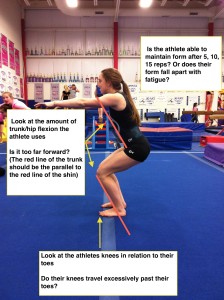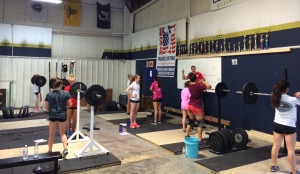Building Off Aly Raisman’s Comment on Increased Ankle Injuries – 5 More Reasons To Consider
Aly Raisman said in an interview recently that she hopes the landing rules may change, so that the next generation of gymnasts may not suffer so many ankle injuries.
She noted almost every athlete on the national team now tapes their ankles, which I’m sure is related repetitive high impact injuries snowballing over time. This certainly is the case with thousands of more gymnasts involved in all levels of the sport. Ankle taping may help to a degree, but it doesn’t fix the true issues as to why injuries occur. These repetitive truamas build up over time to be much more serious issues like Achilles tears, talar dome stress fractures, and very severe bone bruises.
These can sideline athletes for months or an entire season. Even if they are not this severe, they still pose a significant negative impact on training potential. Aly noted that not being able to lunge out of tumbling passes and changes in corner transitions were two concerns of hers.
Before going on more, remember you can download my entire free ebook on Gymnastics Injuries, “The Gymnastis Medical Guide” here,

The Gymnastics Medical Injuries Guide
- Understand the most common injuries in male and female gymnastics, why they occur, and how to prevent them
- Read about the most current science on injuries and rehabilitation in gymnastics
- Get tips on the latest injury risk reduction and rehabilitation practices
We take our privacy seriously and will never share your information. Click here to read our full privacy policy.
I certainly agree with her but think due to this being a sport wide issue there are other factors to consider. Here are 5 of my thoughts,
1. Improper Landing Technique – No matter how much you change the rules for step outs or try to modify choreography, ankles injuries will still happen if a knee and ankle dominated pattern are always used. As I wrote about in this popular article, “Why Gymnast’s Must Change The Way They Land“, the traditionally taught gymnastics landing may not be the best for joint or lower body health. The available science (find more here, here, here, here, and here) and recent injury patterns suggest we need to be teaching proper squat based mechanics with the feet hip width. Read about it more in the article, but dissipating the enormously high 17x body weight force through eccentric muscular contractions in the hips, rather than in passive joint, bone, and ligamentous structures, is the goal.

2. Myths / Misunderstandings About Using External Weights for Strength – This is another controversial but crucial topic gymnastics needs more education on. The more I treat gymnasts and read research, the more firm I become on my views that gymnastics must adopt the use of periodized, formal strength programs that use external load. Injuries occur when tissue load exceeds tissue capacity, either progressively as overuse injury (Achilles tendinopathy) or in once acute incident (ACL tear). The exact goal of using progressive exposure to external weight with proper planning, appropriate recovery and adaptation periods, and proper coaching / technique / supervision, is to enhance the bodies ability to accept and deal with more force over time. I feel his is exactly why so many ankle and other lower body injuries occur over time in gymnastics.
Interestingly enough, a recent meta-analysis in the British Journal of Sports Medicine suggested that strength training was the only notable way to reduce injury risk, with rates being reduced by about 33%. It was not specific to gymnastics, but I strongly feel quality based improvements in landing technique combined with quantity based tissue capacity building are cornerstones of reducing lower body injuries in gymnastics for the next generation. It’s not to say many gyms aren’t already on the right track using external load and correct periodization models, but I think as a whole gymnastics continue to adopt these ideas fully. Our girls team has been using external load for 2 years, and has been weight lifting as an adjunct ot their strength in the summer. I clearly am biased and can’t say I’m producing Olympians, but I feel as though it has been the biggest factor in the reduction in ankle/knee injuries in our gym since I started at my gym 3 years ago. If you are interested, read more on this in an article I wrote, ” Gymnastics and Lifting Weights: Don’t Fear Plates, Kettlebells, and Barbells“.

3. Lacking Ankle Mobility – It’s a natural adaptation of gymnastics for athletes to gain motion into a toe pointed or plantar flexed position, as this position is part of our form execution. This comes with a general loss in toes up or dorsiflexion mobility. Some stiffness and change in motion is necessary for sport performance, but we don’t want to let it get so far gone that a gymnast dramatically loses ankle dorsiflexion needed for proper squatting form, running, and impact landings. Many youth overuse injuries (Sever’s disease, Osgood Schlatters, etc) may have ties to this, and repetitive micro trauma over years may lead to higher risks of achilles tears in fully matured gymnasts. Screening and doing soft tissue maintenance care is something we need to consider. Here is a short video I made going over this.
4. Planning / Outlining The Entire Competition Year – Large volumes of hard landings early in the preseason can come at a big cost. Clearly we want to prepare gymnast for their actual competition settings, but high numbers of hard landings across many events quickly adds up. This is especially true for female athletes who only have 4 events and may train ever event during practice. It’s important we vary the event surface of landing, vary the focus of the events (not impact or dismounts on all events), and also keep note of total landing exposures, especially in the athletes who have a very heavy impact dominant movement profile. We need to think about the overall landscape is training. This goes along with making sure we are planning the weekly training schedule to vary heavy, medium, and light intensity days. This helps to foster appropriate recovery and adaptation, reducing the risk of over training syndrome.
5. Gymnast Readiness For Skill – As a former gymnast, and also as a current coach, I understand that with competition season in full swing we want to compete our highest level vaults, floor passes, and dismounts. Despite this, we always have to consider the long term implications for skills and if the athlete is truly ready to compete them on hard surfaces. Athlete’s are often in a high pressure competition environment, in a situation where the equipment and gym setting is likely not what they are used to practicing ith. Sure, it’s fantastic when they take the risk and make a skill that from practice may not seem ready. However, be willing to deal with the injury consequences if the athlete has a mis hap and lands short, possibly leading to a larger injury that ends their competitions season early. In the clinic at Champion, I’m unfortunately seeing some of these clients now. Another week in the gym building confidence and show that skill for the next competition may go a long way for their ankles.
There is a lot to think about and many more angles past this, but I hope this is helpful for readers. Best of luck,
– Dave Tilley DPT, SCS



